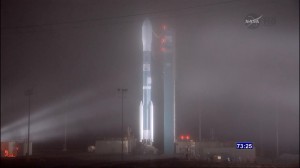 A thick fog has settled in over the launch area, surrounding the Delta II rocket awaiting liftoff from Space Launch Complex 2. The fog is not a problem for launch.
A thick fog has settled in over the launch area, surrounding the Delta II rocket awaiting liftoff from Space Launch Complex 2. The fog is not a problem for launch.
Month: July 2014
LOX Loading Begins
Valves are open and liquid oxygen is beginning to flow into the Delta II rocket’s first stage. This is a cryogenic propellant, meaning it’s cooled to an extremely low temperature — in this case, minus-297 degrees Fahrenheit.
Delta II to Give OCO-2 a Lift to Orbit
OCO-2’s ride into space is the United Launch Alliance Delta II rocket, a vehicle with a lengthy and reliable history. From Earth-observing missions like Aquarius, CloudSat and CALIPSO, to interplanetary voyages such as the Mars Phoenix lander, and astronomy missions like Kepler and WISE, the Delta II has boosted many of NASA’s most well-known missions into Earth orbit and beyond.
The Delta II standing on the launch pad today is 128 feet tall and eight feet in diameter, with a 10-foot payload fairing. The vehicle consists of two stages, plus a trio of solid-rocket boosters attached to the first stage. At T-0, the solids will ignite along with the first stage’s RS-27A engine. The first-stage engine is powered by a combination of liquid oxygen and RP-1, a refined kerosene fuel already on board the rocket. The second-stage tanks already are filled with hypergolic propellants that will burn when they touch each other — no need for an ignition source.
NASA Team Ready for Tanking
NASA Launch Manager Tim Dunn polled his team and gave the go-ahead to begin loading liquid oxygen into the rocket’s first stage a few minutes from now.
Weather Looking Good
Launch Weather Officer Lt. Joseph Round of the 30th Operations Support Squadron just briefed the launch team on this morning’s conditions. With nothing significant on the radar and light winds at about 4 knots, there are no violations of weather criteria and there is virtually no chance of weather interfering with liftoff today. The fog enveloping the launch area is not a concern.
Welcome to the Countdown!
It’s early in the morning at Vandenberg Air Force Base in California, but the launch team has been up through the night preparing for today’s liftoff of NASA’s Orbiting Carbon Observatory-2 aboard a United Launch Alliance Delta II rocket. Launch is scheduled for the start of a 30-second window that opens at 2:56:44 a.m. PDT — that’s 5:56:44 a.m. EDT.
Today’s countdown actually began last night at 10:21 p.m. Pacific Time, when clocks began counting backward from T-minus three hours, five minutes. At Space Launch Complex 2, the rocket’s first and second stages have been pressurized, and loading of liquid oxygen into the first stage is expected to start in about 20 minutes.
The OCO-2 spacecraft will spend at least two years giving us a complete picture of where Earth’s atmospheric carbon dioxide (CO2) comes from — and where it’s going. Plants and oceans all over the planet take up and re-emit this invisible greenhouse gas. NASA is counting on OCO-2 to study this atmospheric give-and-take at a level of detail not available before — and perhaps solve one of Earth’s most closely guarded climate mysteries. More on that later in the countdown.
Launch Viewing Info
“Is there any way I can see the launch?” It’s a common question during every countdown. Try this page for launch viewing suggestions.

